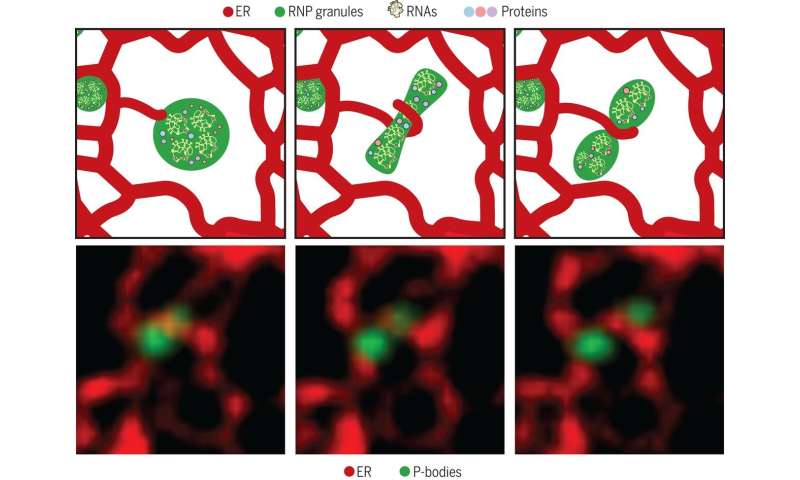Endoplasmic reticulum found to contact at least two membraneless compartments and influence their behavior
by Bob Yirka
A team of researchers at the University of Colorado has found that the endoplasmic reticulum (ER) makes contact with at least two membraneless compartments in cells and influences their behavior. In their paper published in the journal Science, the group describes their work with live-cell fluorescence microscopy of human cells and what they found.
The human body has a class of cells called eukaryotic cells—they are the kind that have a nucleus and organelles and are enclosed within a plasma membrane. Prior research has shown that organelles connect to one another in networks allowing the transport of materials such as metabolites through vacuoles and organelle boundary contact sites. Prior research has also shown that the ER serves as a hub within a cell and physically connects with almost every other membraned organelle in a cell. In this new effort, the researchers have found evidence of an ER also having contact points with membraneless ribonucleoprotein granules.
Membraneless organelles are biomolecular condensates that clump together to form one mass or a whole group of macromolecules inside of cells. Two such types are stress granules and P-bodies —both are considered to be archetypical organelles and reside in the cytoplasm. Membraneless organelles have also been found to occur in the nucleus. Prior research has shown that interactions between membraneless organelles are typically carried out through low-affinity multivalent protein to protein, RNA to protein, and RNA to RNA interactions.
To get a better look at the ER and its contacts, the researchers used live-cell fluorescence microscopy—in which a microscope is used with both phosphorescence and fluorescence to highlight different parts of organic substances. Images of the ER showed tubule dynamics that were spatially and temporally connected to the split site of two types of RNP granules, and also to stress granules and P-bodies. The researchers found that most of the interactions between the ER and P-bodies or stress granules were stable and similar to membrane contact sites. They suspect that the connections allow for exchange of mRNAs between liquid-like droplets self-assembled from proteins and RNAs—where they remain silent until they get to their site of expression in the ER.
More information: Jason E. Lee et al. Endoplasmic reticulum contact sites regulate the dynamics of membraneless organelles, Science (2020). DOI: 10.1126/science.aay7108
Benoît Kornmann et al. Liquid but not contactless, Science (2020). DOI: 10.1126/science.aba3771
Journal information: Science
© 2020 Science X Network